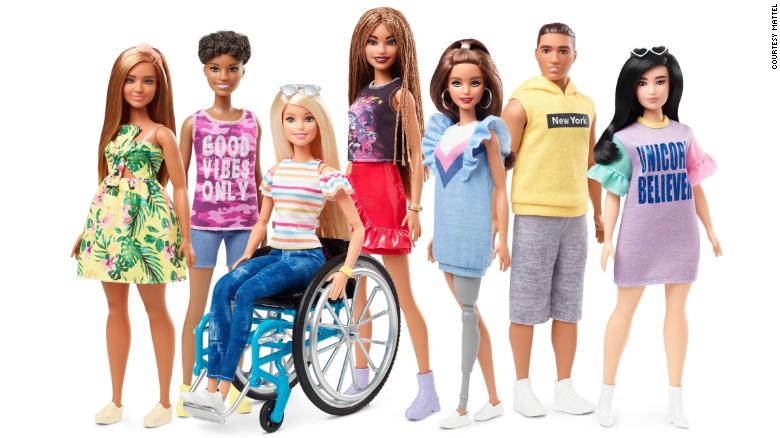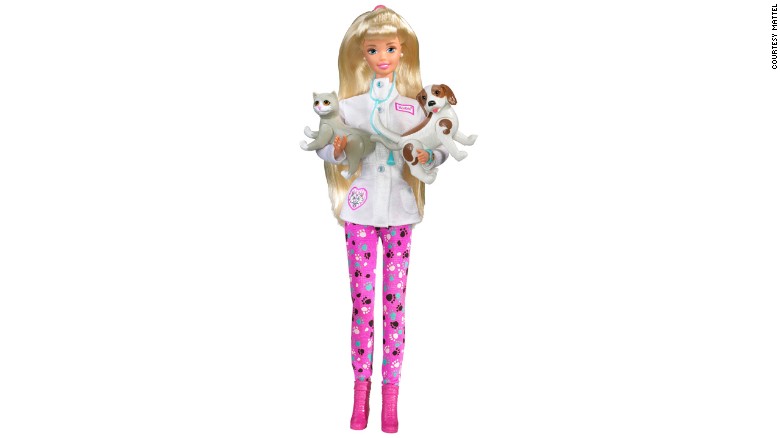20世纪40年代,玩具开始以性别为卖点进行营销
20世纪40年代,玩具开始以性别为卖点进行营销
Parents who want to raise their children in a gender-nonconforming way have a new stocking stuffer this year: the gender-neutral doll.
想要以性别不一致的方式抚养孩子的父母们今年有了一个新的圣诞礼物:中性娃娃。
Announced in September, Mattel's new line of gender-neutral humanoid dolls don't clearly identify as either a boy or a girl. The dolls come with a variety of wardrobe options and can be dressed in varying lengths of hair and clothing styles.
美泰公司9月份发布的新系列中性人形玩偶并没有明确的性别区分。这些娃娃有多种服装选择,可以有不同长度的头发和不同风格的衣服。

Tell a different, inclusive story about Santa this Christmas
今年圣诞节,讲述一个关于圣诞老人的不同的、包容的故事
But can a doll -- or the growing list of other gender-neutral toys -- really change the way we think about gender?
但一个玩偶——或越来越多的其他中性玩具——真的能改变我们对性别的看法吗?
Mattel says it's responding to research that shows "kids don't want their toys dictated by gender norms." Given the results of a recent study reporting that 24% of U.S. adolescents have a nontraditional sexual orientation or gender identity, such as bisexual or nonbinary, the decision makes business sense.
美泰表示,这是对一项研究的回应,该研究表明,“孩子们不希望他们的玩具受到性别规范的支配。”最近的一项研究显示,24%的美国青少年有非传统的性取向或性别认同,比如双性恋或非双性恋,有鉴于此,这一决定在商业上是有意义的。
As a developmental psychologist who researches gender and sexual socialization, I can tell you that it also makes scientific sense. Gender is an identity and is not based on someone's biological sex. That's why I believe it's great news that some dolls will better reflect how children see themselves.
作为一名研究性别和性社会化的发展心理学家,我可以告诉你,这也有科学意义。性别是一种身份,并不是基于一个人的生理性别。这就是为什么我认为一些娃娃能更好地反映孩子们对自己的看法是个好消息。
Unfortunately, a doll alone is not going to overturn decades of socialization that have led us to believe that boys wear blue, have short hair and play with trucks; whereas girls like pink, grow their hair long and play with dolls. More to the point, it's not going to change how boys are taught that masculinity is good and femininity is something less -- a view that my research shows is associated with sexual violence.
不幸的是,一个玩具娃娃并不能颠覆几十年来的社会观念,这些观念使我们相信男孩子穿蓝色的衣服,留着短发,喜欢玩卡车;而女孩子喜欢粉红色,留长发,玩洋娃娃。更重要的是,这不会改变男孩们被教导的阳刚之气是好的,而阴柔之气是不好的——我的研究表明,这种观点与性暴力有关。
Pink girls and blue boys
粉红色的女孩和蓝色的男孩
The kinds of toys American children play with tend to adhere to a clear gender binary.
美国儿童玩的玩具往往有明显的性别二元性。
Toys marketed to boys tend to be more aggressive and involve action and excitement. Girl toys, on the other hand, are usually pink and passive, emphasizing beauty and nurturing.
销售给男孩的玩具往往更有攻击性,包含动作和刺激。另一方面,女孩玩具通常是粉红色的,比较被动,强调美丽和养育之道。

It wasn't always like this.
事情并不总是这样的。
Gift-giving taboos aren't as bad as you think
送礼禁忌并不像你想的那么糟糕
Around the turn of the 20th century, toys were rarely marketed to different genders. By the 1940s, manufacturers quickly caught on to the idea that wealthier families would buy an entire new set of clothing, toys and other gadgets if the products were marketed differently for both genders. And so the idea of pink for girls and blue for boys was born.
在20世纪之交,玩具很少针对不同性别销售。到20世纪40年代,制造商们很快意识到,如果针对男女消费者的营销方式不同,富裕家庭就会购买一整套全新的服装、玩具和其他小玩意。于是,粉色代表女孩,蓝色代表男孩的想法诞生了。
Today, gendered toy marketing in the U.S. is stark. Walk down any toy aisle and you can clearly see who the audience is. The girl aisle is almost exclusively pink, showcasing mostly Barbie dolls and princesses. The boy aisle is mostly blue and features trucks and superheroes.
如今,美国的性别玩具市场十分严峻。走在玩具货架上,你可以清楚地看到谁是观众。女孩通道几乎全是粉红色的,展示的大多是芭比娃娃和公主。男孩通道大部分是蓝色的,以卡车和超级英雄为特色。
Breaking down the binary
打破(性别)二元性
The emergence of a gender-neutral doll is a sign of how this binary of boys and girls is beginning to break down -- at least when it comes to girls.
中性玩偶的出现表明,男孩和女孩的二元对立开始瓦解——至少在女孩身上是这样。
A 2017 study showed that more than three-quarters of those surveyed said it was a good thing for parents to encourage young girls to play with toys or do activities "associated with the opposite gender." The share rises to 80% for women and millennials.
2017年的一项研究显示,超过四分之三的受访者表示,父母鼓励小女孩玩玩具或参加“与异性有关”的活动是件好事。女性和千禧一代的这一比例上升到80%。
But when it came to boys, support dropped significantly, with 64% overall -- and far fewer men -- saying it was good to encourage them to do things associated with girls. Those who were older or more conservative were even more likely to think it wasn't a good idea.
但对于男孩来说,支持度明显下降,总体下降64%,很少有男性说鼓励他们做与女孩有关的事情是有好处的。那些年龄较大或更保守的人更有可能认为这不是一个好主意。


















